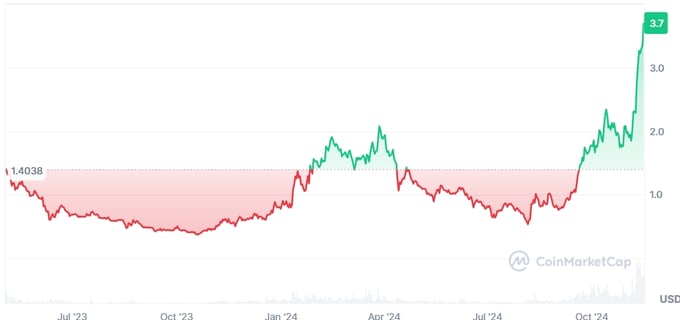What is Sui Network (SUI): The ultimate guide


Sui is a layer-1 blockchain designed to facilitate fast, low-latency transactions, making it an excellent choice for real-time applications such as gaming, decentralized finance (DeFi), and other high-performance services. Launched in May 2023, Sui's architecture focuses on instant transaction finality and high throughput. Its smart contracts are written in Move, a Rust-based programming language tailored for secure and efficient transaction execution.
What sets Sui apart is its innovative transaction processing model. Unlike traditional blockchains that process transactions sequentially, Sui can handle multiple transactions simultaneously. This reduces network congestion and achieves a throughput of nearly 300,000 transactions per second by employing transaction parallelization. This approach enables independent transactions to be processed concurrently, using data structured as distinct objects.
In simpler terms, transactions that don't rely on one another can be executed in parallel by Sui nodes. The network employs a Byzantine fault-tolerant Delegated Proof-of-Stake (DPoS) consensus mechanism to maintain security and reliability.
Sui is a layer-1 blockchain optimized for fast, low-latency transactions, making it an excellent fit for real-world gaming applications and other demanding services like decentralized finance (DeFi). Launched in May 2023, Sui’s architecture is designed to deliver instant transaction finality and high throughput. Its smart contracts are built using Move, a Rust-based programming language tailored for secure and efficient transaction processing.
What makes Sui stand out is its innovative transaction processing model. Unlike traditional blockchains that handle transactions sequentially, Sui processes multiple transactions in parallel. This use of transaction parallelization helps minimize network congestion, achieving a throughput of nearly 300,000 transactions per second. The model relies on structuring data as distinct objects, enabling independent transactions to be processed concurrently.
In practical terms, Sui nodes can execute independent transactions simultaneously. The network ensures security and operational reliability through a Byzantine fault-tolerant Delegated Proof-of-Stake (DPoS) consensus mechanism.
These and other standout features have propelled Sui into the upper echelons of the crypto market. More than a year after its launch, the network has reached several significant milestones, attracting a growing number of users. Dubbed the "Solana Killer," Sui continues to gain traction for its innovative approach and performance.
According to Artemis data, daily active addresses on the network hit a peak in September 2024, driven by the surge in the value of its native token, SUI. The token reached an all-time high of $2.36 during this period, pushing its market capitalization close to $4.9 billion. Following this, SUI experienced another rally, climbing to a peak of $3.70 in November 2024.
Sui distinguishes itself from other blockchains through several technical advancements. It utilizes a Delegated Proof-of-Stake (DPoS) consensus mechanism, where a set of validators are responsible for confirming transactions and producing new blocks. A validator’s voting power is proportional to the number of SUI tokens they hold, incentivizing token ownership and network participation.
Additionally, Sui integrates zero-knowledge proofs (ZKPs) to enhance user privacy and transaction security. It employs Groth16—a variant of zk-SNARKs—within its Move programming language to efficiently execute ZKPs, aligning with the network's high-speed transaction requirements. This combination ensures the ability to handle high transaction volumes while maintaining secure and efficient proof verification.
Through the use of ZKPs, Sui provides:
Confidential Transactions: Users can validate sufficient funds for a transaction without exposing detailed financial information.
Secure Identity Verification: ZKPs enable authentication processes that protect personal data, making them ideal for applications requiring privacy-preserving user verification.
Sui’s Delegated Proof-of-Stake (DPoS) mechanism is powered by an advanced consensus engine called Mysticeti, which delivers near-instant transaction finality, achieving completion times under a second. In blockchain terms, "finality" refers to the moment when a transaction becomes irreversible, a critical feature for applications requiring both speed and certainty, such as gaming and high-frequency DeFi trading.
At the heart of Mysticeti's efficiency is its use of a Directed Acyclic Graph (DAG) structure. If you’ve encountered DAGs before and found them challenging to grasp, you’re not alone—they can be quite complex. However, here’s a simplified way to think about them:
Directed: Paths flow in a single direction, like a one-way street. For example, if you move from point A to point B, you can’t return to A along the same path.
Acyclic: No loops are allowed. Once you move forward, you can’t circle back to where you started, ensuring a linear, one-way progression.
DAGs are essentially a way to organize information in a clear, non-repetitive flow. They help ensure that tasks or events are completed in the right order, where no step is repeated or reversed. This logical structure is especially useful in blockchains because it enables multiple processes to occur simultaneously, significantly improving data acquisition and transaction speed.
Several prominent blockchains, like Avalanche and IOTA, also leverage DAG technology for enhanced performance. By allowing operations to proceed in parallel, DAGs eliminate the bottleneck of sequential processing common in traditional blockchains.
However, implementing DAGs is no easy feat. While they’ve been around for years, they remain highly complex and have yet to be fully stress-tested at maximum capacity. Despite this, their potential for improving blockchain scalability and efficiency continues to make them a promising area of innovation.
The Sui object-oriented framework reimagines how on-chain data is structured, accessed, and managed in a new way. This is different from traditional models, such as UTxO or account-based systems, with the aim of significantly scaling, flexing, and making the developer experience easier. Some of the key features of Sui's object-oriented framework include but are not limited to:
1. Everything is an Object
In Sui, everything is treated as a unique object with its identity, ownership, and properties. This design makes management of digital assets and state changes straightforward, as for instance:
Ownership and Transfer: Treating digital assets like tokens or NFTs as separate objects makes their transfers as simple as manipulating physical objects.
Independent Processing: When transactions involve independent objects, parallel execution is possible, improving scalability and throughput by not allowing any kind of bottleneck in transaction processing.
2. Dynamic Asset Management
Sui supports multiple kinds of objects, each fitting different use cases:
Owned Objects: Modification is allowed only by the owner of the object. In this way, safety of asset ownership is guaranteed.
Shared Objects: Those shared between several users. It is guaranteed to maintain their consistency through consensus mechanisms.
Immutable Objects: Permanent, unchangeable-whose data is expected not to change over time. They serve as trusted references.
This allows developers to build applications including multi-levelled ownership and dynamic, often mutating assets without the rigidity of traditional blockchain models. Whether providing for singular one-of-a-kind NFTs, shared access models, or immutable records, Sui's object-oriented approach opens a world of creative use cases.


Digitalcogni
Explore technology, crypto, and AI insights daily.
Connect
contact@digitalcogni.com
© 2024. All rights reserved.
